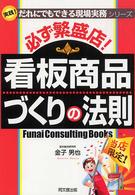- ホーム
- > 洋書
- > 英文書
- > Literary Criticism
Full Description
The Number Sense of Nineteenth-Century British Literature considers how the avalanche of printed numbers characterizing the period affected its literature. It looks at the influence of a variety of cultural and historical movements, such as the rise of statistics and of democratic Liberalism and concurrent developments in mathematics. This book takes as its starting point and focus the presence of actual numbers--ordinal and cardinal, Arabic, Roman, and spelled out in words--within the century's literary texts. It is through the deployment of such figures that texts display their number sense; similarly, readers develop the faculty of number sense by paying careful attention to their presence. And contemplation of a text's use of numbers, while frequently pointing to specific historical contexts, also enables more fundamental recognitions about how literature makes meaning.
The Number Sense asks what kinds of work, intellectual and ethical, literature's numerical figures perform. Why are some writers especially prone to include numbers? What affordances do they wield in various literary environments and against the backdrop of the numbery nineteenth century? When do textual numbers really count and when do they ask us to keep count? How do they stage contests between the one and the many, individuals and collectives? How do they relate to formal aspects of works, like plot and character, narrative, and lyric Lingering over literary measures illuminates the way numbers help shape texts into the recognizable forms we call genres. To that end, the book considers the works of poets, like Tennyson, Wordsworth, and Byron, and of novelists working in a broad range of genres, including Jane Austen, George Gissing, Charles Dickens, Anthony Trollope, Lewis Carroll, Bram Stoker, Wilkie Collins, and Thomas Hardy. The numbers embedded in their fictions and verse can serve both as valves, releasing cultural pressures, and as fulcrums, places where pressures coincide to create new forms of literary agency.
Contents
0.1: Introduction
1: Byron's Counts
2: Jane Austen, by Half
3: Figuring Character in Dickens
4: Plotting Age in Trollope
C.1: Conclusion
Bibliography
Index








